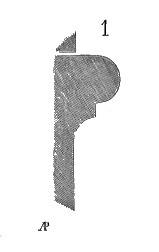Astragal


An astragal is a moulding profile composed of a half-round surface surrounded by two flat planes (fillets). An astragal is sometimes referred to as a miniature torus. It can be an architectural element used at the top or base of a column, but is also employed as a framing device on furniture and woodwork.
The word "astragal" comes from the Greek for "ankle-joint", αστράγαλος, astrágalos.[1]
On doors
An astragal is commonly used to seal between a pair of doors. The astragal closes the clearance gap created by bevels on one or both mating doors, and helps deaden sound. The vertical member (molding) attaches to a stile on one of a pair of either sliding or swinging doors, against which the other door seals when closed. Exterior astragals are kerfed for weatherstripping. The weatherstripping at the bottom of garage doors is also referred to as an astragal.
An astragal may also be known as a "meeting stile seal". It is sometimes confused with the wooden trim that divides the panes of a multi-light window or door, known as a muntin.
References
- ^ One or more of the preceding sentences incorporates text from a publication now in the public domain: Chisholm, Hugh, ed. (1911). "Astragal". Encyclopædia Britannica. Vol. 2 (11th ed.). Cambridge University Press. p. 794.
- "What The Heck Is an Astragal?". The Galoot's Progress. Archived from the original on 2013-01-22. Retrieved November 2, 2012.
- "Ultimate Astragal". Endura Products. Archived from the original on 2008-09-14.
- "Astragal: definition". Oxford Dictionaries.
